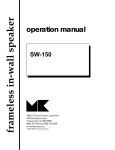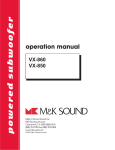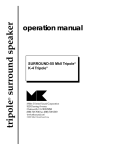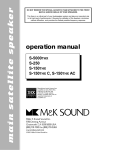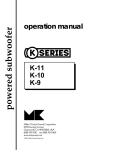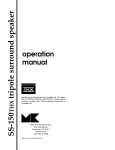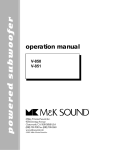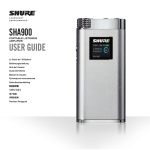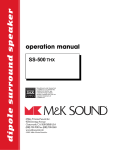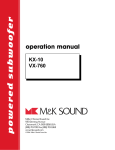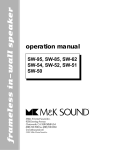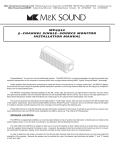Download MK Sound CS-150 Speaker System User Manual
Transcript
tripole® column surround speaker operation manual CS-150 Tripole® CS-35 Tripole® CS-29 Tripole® CS-22 Tripole® TM Miller & Kreisel Sound, Inc. 9351 Deering Avenue Chatsworth, CA 91311-5858 USA (818) 701-7010 fax (818) 701-0369 www.mksound.com ©2002 Miller & Kreisel Sound, Inc. COLUMN SURROUND SPEAKER TABLE OF CONTENTS 1. 2. 3. 4. 5. 6. 7. 8. 9. 10. 11. 12. 13. INTRODUCTION...........................................................................................................3 THE COLUMN SURROUND SPEAKER..........................................................................3 THE TRIPOLE® SURROUND CONCEPT.........................................................................3 SPEAKER HOOK-UP........................................................................................................4 SPEAKER PLACEMENT..............................................................................................5 COLUMN SURROUND MOUNTING OPTIONS..............................................................7 CUSTOM MODES AND REMOTE OPERATION (CS-150 ONLY).............................9 SPEAKER POLARITY TEST..........................................................................................10 SPEAKER DAMAGE & HOW TO AVOID IT...................................................................11 IF YOU NEED SERVICE.................................................................................................11 M&K TEN YEAR WARRANTY........................................................................................11 CABINET MAINTENANCE.............................................................................................12 SPECIFICATIONS..........................................................................................................12 DIAGRAMS FIGURE FIGURE FIGURE FIGURE FIGURE FIGURE FIGURE FIGURE FIGURE FIGURE FIGURE 1 2 3 4 5 6 7 8 9 10 11 BASIC WIRING OF THE COLUMN SURROUND SPEAKER...............................4 WIRING THE SURROUND SPEAKER (CS-150 ONLY)......................................4 DIPOLE OPERATION (CS-150 ONLY)..................................................................5 TRIPOLE® OPERATION (CS-150 ONLY).............................................................5 LOCATING THE SPEAKER NEXT TO THE LISTENER........................................6 LOCATING THE SPEAKER BEHIND THE LISTENER........................................6 SPEAKER LOCATION WITH ONE ROW OF LISTENERS.................................6 SPEAKER LOCATION WITH TWO ROWS OF LISTENERS..............................6 USING 4 SURROUND SPEAKERS....................................................................7 USING A SINGLE REAR CENTER SURROUND SPEAKER...............................7 REMOTE SWITCHING OF MODES (CS-150 ONLY).........................................10 Please record the following information for your records: Serial Number: Date of Purchase: Dealer Name: Dealer Address: City/State/Zip: Country: Invoice Number: 2 COLUMN SURROUND SPEAKER 1. INTRODUCTION Congratulations! Your new M&K Tripole® surround speaker will give you years of unmatched enjoyment and excitement while listening to your favorite musical and audio/video sources, whether in DVD-Audio, Dolby Digital, DTS or other discrete multichannel digital systems, Dolby Pro-Logic, or your processor's enhanced music surround modes. We encourage you to read this owner’s manual, as there is a great deal of information provided here to help you get the best possible performance. If you have any questions about your speaker system, please contact your M&K dealer or call the M&K factory directly at (818) 701-7010, from 8:30 AM to 5:00 PM Pacific Time, Monday through Friday. We will be happy to help you with any question. Alternatively, you may send an e-mail to [email protected] or you can also access our web site at: www.mksound.com. 2. THE COLUMN SURROUND SPEAKER A new concept in surround channel loudspeakers, the M&K Column Surround gives listeners an option for high quality sound in a home theater when they cannot place the surround speakers up on a wall. With its unprecedented combination of style and functionality, this real-world speaker solution lets you hear audiophilequality sound from the surround channels of your multichannel speaker system -- without disrupting your room environment. Out in the open, or behind a couch, chair, or other furniture, they sound and look great! You can place your Column Surrounds virtually anywhere in your room. On its pedestal base, a freestanding Column Surround can be located out in the open or behind a couch, chair, or other furniture. And with its baseboard mount, you can permanently secure it to the base of any wall, without sacrificing any floor space. Using exceptionally high-quality European drivers, the Column Surrounds produce a brilliant sound quality with an incredibly large sound, evoking the quality of M&K professional monitors. You’ll hear the world-class sound quality that has made M&K the choice of professionals. Each Column Surround model uses M&K’s exclusive Tripole® design to deliver remarkably uniform coverage of sound in the listening room. Regardless of where listeners are seated, they will hear a smooth response, with good sonic imaging and envelopment. The Column Surround radiates sound simultaneously as a dipole (from its left and right baffles) and a direct radiator (from its front/top baffle), thereby combining the diffused, spacious sound of a dipole speaker with the immediacy and imaging capability of the best direct radiating speakers. 3. THE TRIPOLE® SURROUND CONCEPT The Tripole® is a new concept in surround channel speaker design, offering the performance aspects of two different types of speakers. Think of it as a dipole surround speaker that includes a very high quality direct radiating speaker in the same cabinet. As a Tripole®, the front baffle drivers (direct radiator) operate full range. The side Dipole drivers also operate, so sound is radiated on three axis. This means that the speaker can simultaneously produce a directional stereo image in the surround channels and an enveloping sound that wraps around the listeners. The directional qualities and stereo imaging may be preferred for playing back the "split" (stereo) surrounds of 5.1 channel discrete digital recordings 3 COLUMN SURROUND SPEAKER CS-150 ONLY The CS-150 speaker can operate in two modes: Tripole® or Dipole. You can select these modes by inserting or removing a jumper on the back of the speaker. They also can be accessed by using an external amplifier switchbox (not available from M&K). The mode you should use is dependent on your room environment, the source material you are playing, and your personal preference. The CS-35, CS-29, and CS-22 operate in Tripole® mode at all times. When the CS-150 is operated in the Dipole mode, it radiates sound mostly from its left and right baffles. Some sound (in the midbass region) is produced by the front woofer driver. Most users will set the speaker to a single mode for all playback, and we recommend that the choice be made based upon room conditions. Still, some users may prefer the Dipole mode for some material and the Tripole® mode for other material. If you have questions regarding this, please contact your M&K dealer or the M&K factory. 4. SPEAKER HOOK-UP LEFT SURROUND SPEAKER / RIGHT SURROUND SPEAKER Your Tripole® speakers come in left and right channel versions. Externally, both speakers may appear to be identical, but in fact it is critical that the correct speaker be used in each channel. On the back of the speaker is a label identifying the speaker as a left channel or a right channel speaker. If you are using multiple surround speakers or have a 6.1 channel system, make sure that all surround speakers are being used in the proper (right or left) channel. WIRING THE SURROUND SPEAKERS The Positive ( + ) lead from your amplifier or receiver should be connected to the RED ( + ) "INPUT" terminal, and the Negative ( — ) lead from your amplifier or receiver should be connected to the BLACK ( — ) "INPUT" terminal. See Figure 1. For the CS-150, the Positive ( + ) lead from your surround channel amplifier or receiver should be connected to the RED ( + ) "INPUT" terminal labeled "1", and the Negative ( — ) lead from your amplifier or receiver should be connected to the BLACK ( — ) "INPUT" terminal labeled "2". See Figure 2. FIGURE 1 FIGURE 2 BASIC WIRING FOR CS-35, CS-29, CS-22 COLUMN TRIPOLE® SURROUND SPEAKER (One channel only is shown for clarity) BASIC WIRING WITH THE CS-150 TRIPOLE® SURROUND SPEAKER (One channel only is shown for clarity) COLUMN SURROUND (Terminals at bottom of the column) Connect your amplifier to terminals 1 and 2 + 1 INPUT 4 ohms 2 FOR THX (DIPOLE) OPERATION: remove jumper between terminals 3 and 4 + - + - 3 4 + LEFT SURROUND AMPLIFIER OR RECEIVER 4 MILLER & KREISEL SOUND CORPORATION 9351 Deering Avenue, Chatsworth, CA 91311 818/701-7010 fax: 818/701-0369 www.mksound.com - + RIGHT SURROUND DO NOT CONNECT YOUR AMPLIFIER TO TWO RED TERMINALS. For remote control operation, see your owner's manual. FOR TRIPOLE OPERATION: install jumper between terminals 3 and 4 LEFT SURROUND TRIPOLE SURROUND SPEAKER - + RIGHT SURROUND COLUMN SURROUND SPEAKER TRIPOLE® OR DIPOLE OPERATION (CS-150 ONLY) To operate in the Tripole® mode, the jumper between the terminals labeled "3" and "4" must be in place. To operate the speaker in the Dipole mode, the jumper between the terminals labeled "3" and "4" must be removed. Do not throw away or lose this jumper. See Figures 3 and 4. VERY IMPORTANT: The sensitivity of the speaker is slightly higher in the Tripole® position. For critical listening, when switching from one mode to another, you should re-calibrate the level of the surround channels. FIGURE 3 1 Connect your amplifier to terminals 1 and 2 WIRING FOR DIPOLE OPERATION (CS-150 ONLY) (Only one channel is shown) Disconnect the Jumper between terminals 3 and 4 TRIPOLE SURROUND SPEAKER INPUT 4 ohms 2 FOR THX (DIPOLE) OPERATION: remove jumper between terminals 3 and 4 DO NOT CONNECT YOUR AMPLIFIER TO TWO RED TERMINALS. For remote control operation, see your owner's manual. 3 FOR TRIPOLE OPERATION: install jumper between terminals 3 and 4 MILLER & KREISEL SOUND CORPORATION 4 9351 Deering Avenue, Chatsworth, CA 91311 818/701-7010 fax: 818/701-0369 www.mksound.com - + LEFT SURROUND - + RIGHT SURROUND FIGURE 4 WIRING FOR TRIPOLE® OPERATION (CS-150 ONLY) (Only one channel is shown) Connect the Jumper between terminals 3 and 4 (Factory default) Connect your amplifier to terminals 1 and 2 1 TRIPOLE SURROUND SPEAKER INPUT 4 ohms 2 FOR THX (DIPOLE) OPERATION: remove jumper between terminals 3 and 4 DO NOT CONNECT YOUR AMPLIFIER TO TWO RED TERMINALS. For remote control operation, see your owner's manual. 3 FOR TRIPOLE OPERATION: install jumper between terminals 3 and 4 4 MILLER & KREISEL SOUND CORPORATION 9351 Deering Avenue, Chatsworth, CA 91311 818/701-7010 fax: 818/701-0369 www.mksound.com - + LEFT SURROUND - + RIGHT SURROUND 5. SPEAKER PLACEMENT The Column Surround speaker takes a unique new approach to producing high-quality sound from the surround channels in the listening room. Conventional surround speakers must be mounted on the side walls, back wall, or ceiling of the room in order to produce good sound. But the Column Surround speaker can be located virtually anywhere in the room to produce a very effective coverage of sound. 5 COLUMN SURROUND SPEAKER Your Column Surround speaker uses M&Ks proprietary Tripole technology to radiate sound into the room at multiple angles. In all models, two side-firing Dipole drivers help to create an enveloping sound quality while a high-quality woofer and tweeter create a more directional sound. In the CS-150, these drivers radiate forward, and in the CS-35, CS-29, and CS-22, these drivers radiate upward. The CS-35, CS-29, and CS-22 also have an additional 6.5" woofer to provide greater output at low frequencies. Column Surrounds are designed to be used as surround channel speakers in any high-performance surround system. They work well in 5.1, 6.1, and 7.1 (or more) channel systems. While they are not THX approved, they provide excellent results when used in combination with other Home THX speakers and electronics. They are not specifically designed to be used as front channel or as stand-alone stereo speakers, but they do work remarkably well in this application, so feel free to experiment with them if you are so inclined. FIGURE 5 CS-150, CS-35, CS-29, CS-22 Left Right Center There are four Column Surround models. The CS-150 is based on M&Ks SS-150THX surround speaker, and the other three models are based on M&Ks Surround-25. The CS-35, CS29, and CS-22 use the same components with the only difference being each cabinets height. In general, the Column Surrounds, like all surround speakers, work best when placed to the side of the listening area or behind the listening area. They can be placed directly against side walls or directly against the back wall of the room. M&K’s Tripole design radiates sound effectively to the sides of the speaker as well as up towards the ceiling. Right Surround Left Surround FIGURE 6 Left Right Center It is not necessary to place the speakers against a wall. They will provide excellent sound away from walls, and can be more easily concealed from view when they are placed next to furniture. On its pedestal base, a freestanding Column Surround can be located out in the open or behind a couch, chair, or other furniture. For example, a CS-22, with a height of only 22 inches, can be hidden from view behind even a small table, and the CS29 and CS-35 can hide behind larger furniture such as chairs and couches. See Figure 5 and 6. Listener Right Surround Back Surround FIGURE 7 Left POSITION RELATIVE TO SEATING Right Center The Column Surrounds work best when located either adjacent to or behind the seating position. When there is one row of seats in the room, the best sound is usually achieved with the speakers located directly to the left and to the right of this row of seats. See Figure 7. If your home theater has multiple rows of seats, the speakers usually work best when located directly to the left and right of the geometric center of the listening area. See Figure 8. Left Surround Right Surround FIGURE 8 When you can’t place the speakers to the sides of the seating area, it is better for them to be located towards the back of the room and behind the listeners seats, rather than in the front of the room (between the listeners and the screen). Because these speakers are so flexible, you can achieve good results simply by making sure that the left surround speaker is in the back of the left side of the room and that the right surround speaker is in the back of the right side of the room. 6 Left Right Center Left Surround Right Surround COLUMN SURROUND SPEAKER If you are having difficulty finding a suitable location in your room, please contact the M&K factory by phone or by email. We will be happy to assist you. FIGURE 9 Left Right Center USING MULTIPLE PAIRS OF SURROUND SPEAKERS Some listeners prefer multiple pairs of surround speakers. In very large rooms, this is certainly desirable and may even be necessary. Multiple speakers can make a dramatic improvement to provide a broader and deeper surround effect. When using multiple pairs of surround speakers, a symmetrical installation pattern works best. For example, one pair could be placed on the back wall of the room, equidistant from the back corners, with a second pair against the side walls of the room, equidistant from the same back corners. See Figure 9. Of course, in most living environments, a completely symmetrical pattern may be difficult if not impossible, so we recommend that you follow a straight forward approach. Listener Left Surround 30°- 45° 30°- 45° Right Surround Right Back Surround Left Back Surround FIGURE 10 Left Right Center Here are some suggestions. If your receiver or processor has outputs for both side and rear speakers, place the left side speaker in the left side of the room, forward from the back wall. Place the left rear speaker in the left rear area of the room near or against the back wall. Place the right channel speakers using the same guidelines. If your receiver or processor has only one set of surround channel outputs for each channel, connect both left speakers to the left output and both right speakers to the right output. If you have a single rear center surround channel, then place the speaker directly behind the listener. See Figure 10. As always, please feel free to call the M&K factory if you have any questions. Listener Left Surround Right Surround Center Back Surround 6. COLUMN SURROUND ASSEMBLY OPTIONS You have two assembly options with your Column Surround speakers. By mounting them to the provided free-standing base, you can locate them virtually anywhere in a room and move them with ease. You can also mount them permanently using the included bracket that attaches to the baseboard at the bottom of any wall. When mounted on the free-standing base, the speaker can sit against a wall, in the open, and even under furniture such as chairs, couches, and tables. The baseboard bracket takes up a minimum of floor space and can also be used to mount the speaker behind furniture located near the wall. ASSEMBLING THE COLUMN SURROUND WITH THE FREE-STANDING BASE Here are the parts you need: 2 each: 2 each: 4 each: Column Surround Speakers Bases CS-35, CS-29, CS-22: 10" x 11" CS-150: 8" x 9 3/8" 1/4 -20 x 1" Phillips Pan Head machine screw (PN 20590) TOOLS REQUIRED: Phillips screwdriver 7 COLUMN SURROUND SPEAKER CS-150 CS-22, CS-29, CS-35 ASSEMBLY Remove the contents of the carton and make sure that you have all the parts. OR Fasten the base to the first Column Surround. You will use the 1/4-20" Phillips Pan Head screws. Making sure that the top speaker grille is in place (CS-35, CS-29, CS-22 only), turn the speaker over so that the two threaded screw inserts on the bottom of the pedestal are facing upward. Do not remove these 4 screws Use two 1/4 - 20 x 1" Phillips Pan Head screws to attach the pedestal to the base. You will first need to remove the screws that have already been mounted in the speaker at the factory. Discard these screws and use the 1/4 - 20 x 1" Philips screws, making sure that they are securely fastened so that the stand is stable. Note that there is a recess at the bottom of the back baffle of the Column Surround cabinet just above the point where the base is attached. When the base is attached, this forms a channel that can be used for speaker wire routing. Do not remove the 4 screws located at the rear of the Column Surround (see diagram). Repeat these instructions to assemble the second stand. MOUNTING THE COLUMN SURROUND TO THE BASEBOARD Here are the parts you need: 2 2 8 4 each: each: each: each: Column Surround Speakers Baseboard Mounting Brackets #6-32 x 1" Flat Head machine screw (PN 20356) #8 x 1-1/2" Flat Head wood screws (chrome) TOOLS REQUIRED: Phillips screwdriver ASSEMBLY Remove the contents of the carton and make sure that you have all the parts. Inorder to fasten the Wall Mount Bracket to the Column Surround speaker. You will use the #6 - 32 x 1" Flat Head machine screws. Remove the existing 4 screws at rear of cabinet. The screws used to attach the bracket mount into the four threaded inserts found at the rear of the back baffle of the Column Surround. For the CS-35, CS-29, and CS-22, this is directly behind the 6.5" woofer. You will first need to remove the round head screws that are installed at the factory before shipment. Set these round head screws aside and mount the bracket using the #6 - 32 x 1" Flat Head screws. Side with countersunk holes faces outward 8 COLUMN SURROUND SPEAKER You have two sets of mounting locations (4 holes per set). You can use either set of mounting holes on the mounting plate to adjust the location of the speaker depending on the floor covering and the moulding at the base of the wall. First drill a 1/8" pilot hole to a depth of 1", at a downward angle of 15 degrees. Then use the two # 8 x 1-1/2" Flat Head Wood Screws to attach the Wall Mount Bracket to the baseboard. Angle the screw at a 15 degree angle when fastening the screw through the wall plate. Have a helper hold the speaker securely against the wall while you attach the screws. Note that there is a recess at the bottom of the back baffle of the Column Surround cabinet that forms a channel that can be used for speaker wire routing. Repeat these instructions to mount the second stand. If you have further questions about assembling your column Surrounds, please call the M&K factory at (818) 701-7010 or through email at [email protected]. 7. CUSTOM MODES & REMOTE OPERATION (CS-150 ONLY) IMPORTANT: The following options are provided for enthusiasts and installers who wish to experiment with their systems. The design of the CS-150 Tripole® speaker provides a tremendous amount of flexibility. Because it is designed as if it is two separate speakers (a Direct radiator and a Dipole), you can independently vary the amount of output from either the Direct radiator or the Dipole elements. By adjusting the ratio of sound produced by these elements, you can fine-tune the speaker to your listening environment or personal preference. You make these adjustments by choosing which input terminals, jumpers, and (if desired) resistors are used to connect the speaker to the amplifier. PLEASE NOTE: The sensitivity of the speaker is slightly different in each of the surround modes. For critical listening, when switching from one mode to another, you should re-calibrate the level of the surround channels. Regardless of configuration, the Ground (-) lead from the amplifier must connect to Terminal 2. a. Dipole Mode To operate in the Dipole mode, connect the positive (+) lead to Terminal 1. Use no jumper. b. Tripole® Mode To operate in the Tripole mode, must connect the positive (+) lead to Terminal 1 and insert the jumper between terminals 3 and 4. c. Tripole® With Attenuated Dipole Elements Compared to the standard Tripole® configuration, the output from the Direct (front) drivers will be unchanged, but there will be significantly reduced output from the Dipole (side) drivers. To attenuate the Dipole elements, connect the positive (+) lead to Terminal 3, and insert the jumper between terminal 3 and 4. d. Tripole® With Adjustable Attenuated Direct Radiator Compared to the standard Tripole® configuration, the output from the Dipole (side) drivers will be unchanged, but there will be reduced output from the Direct drivers. This configuration will give you a sound more like the Dipole configuration. To adjust the attenuation of the Direct Radiator element, connect the positive (+) lead to Terminal 1 and insert a 5 watt resistor between terminals 3 and 4. The resistor can be any value between 2 and 11 ohms. The larger the value of the resistor, the greater the attenuation. 9 COLUMN SURROUND SPEAKER e. Tripole® With Adjustable Attenuated Dipole To adjust the attenuation of the Dipole element, connect the positive (+) lead to Terminal 3 and insert a 5 watt resistor between terminals 3 and 4. The resistor can be any value between 2 and 11 ohms. The larger the value of the resistor, the greater the attenuation. f. Tripole® With Maximum Output From All Drivers (2.4 ohm impedance) Compared to the standard Tripole® configuration, the output from the Dipole (side) drivers will be unchanged, but there will be significantly greater output from the Direct (front) drivers. To get maximum output from all drivers, connect the (+) lead from the amplifier to Terminal 1. Connect a jumper wire between Terminal 1 and Terminal 3. CAUTION: This configuration presents a 2.4 ohm load to the amplifier. Do not use this configuration unless your amplifier is rated to 2 ohms. g. Direct Radiator Only Mode There will be very little output from the Dipole (side) drivers. To operate as a Direct Radiator, connect the (+) lead from the amplifier to Terminal 3. Use no jumper. Remember, regardless of configuration, the Ground (-) lead must always connect to Terminal 2. REMOTE SWITCHING OF MODES (CS-150 ONLY) If you want to be able to switch between any of the above modes, you can do so by using a speaker level switch box. The specific instructions will vary according to the particular switcher you are using and so this section is intended to be general in nature. To switch between THX Dipole mode and Tripole® mode, connect one wire between Terminal 3 and the switcher Input. Connect a separate wire between Terminal 4 and one of the switcher outputs. For the THX Dipole mode, the switcher output connected to Terminal 4 should be turned off. For the Tripole® mode, the switcher output should be turned on. Nothing else should be connected to the switch box, especially your amplifier. As another example, you can also use a switcher to direct the (+) signal from the amplifier to either Terminal 1 or Terminal 3, to switch between some of the custom modes described above. See Figure 5. Amplifier or Receiver FIGURE 11 LEFT SURROUND + Connect your amplifier to terminals 1 and 2 RIGHT SURROUND + - - TRIPOLE SURROUND SPEAKER 1 INPUT 4 ohms 2 FOR THX (DIPOLE) OPERATION: remove jumper between terminals 3 and 4 3 FOR TRIPOLE OPERATION: install jumper between terminals 3 and 4 - DO NOT CONNECT YOUR AMPLIFIER TO TWO RED TERMINALS. For remote control operation, see your owner's manual. 4 Miller & Kreisel Sound Corporation 9351 Deering Avenue, Chatsworth, CA 91311 818/701-7010 fax: 818/701-0369 www.mksound.com + OUTPUT - B - + OUTPUT - A - + INPUT Switch Box CAUTION: DO NOT WIRE THE SWITCH BOX SO TERMINAL 2 CAN BE CONNECTED TO ANY OTHER TERMINAL. If Terminal 2 is connected to Terminal 1, 3, or 4, the output of the power amplifier will be shorted, which will almost certainly damage the amplifier. 8. SPEAKER POLARITY TEST In any system using a subwoofer separate from Satellite speakers, especially in multi-channel surround sound applications, a polarity test must be performed to insure proper phase in the system, in order to achieve optimum sound in the critical bass frequencies. Therefore, you must have correct phase among all the speakers in the system. We recommend using a test disc to compare the phase of the front channels, surround channels, and subwoofer. Test by comparing the phase between individual channels (starting with the front right and left) until you have established that all units have identical phase. 10 COLUMN SURROUND SPEAKER 9. SPEAKER DAMAGE & HOW TO AVOID IT An important factor to consider with any speaker system is the potential for speaker damage. Even though your speakers have high power handling ability, they still can be damaged by relatively low powered amplifiers. While very few M&K speakers ever need service, the vast majority of those returned are not for manufacturing defects. Instead, they are returned because they have been overdriven, and almost always because the amplifier used was driven into clipping distortion. This damage is abuse, and is not necessarily covered under warranty. This distortion occurs when the demands of the music are greater than the amplifier's power. It can occur at 20 watts with a small amplifier, or at 400 watts with a large amplifier. Regardless, when this happens, the amplifier's output waveform (which usually looks like a smooth arc) is "clipped" off, exhibiting a flat top instead of the arc. This flat top contains multiples of the original amplified frequencies, sometimes at higher levels than the original signal itself. For tweeters, this can be very damaging, as this distortion is well above the audible range, where you will be unable to hear it, and where the tweeter is more vulnerable to damage. When an amplifier clips, its sound becomes harsh and grating, and a break-up is often audible in the bass frequencies. It will become uncomfortable to listen to, compared to a slightly lower volume level. When you are listening at high volume levels, be aware of the onset of clipping distortion, and turn the volume down slightly if the sound takes on the character described above. When tone controls or equalizers are used to boost frequencies, the problem occurs much more rapidly. Even a small boost of low or high frequencies can easily double the power requirement and lead to amplifier clipping at moderate levels. Therefore, you should use your tone controls judiciously avoiding extreme boosts of the bass and treble controls, especially when you are listening at high volume levels. The best way to avoid speaker damage is to use common sense. Use moderate boosts of tone controls or equalizers, at the very most. Listen carefully for any harshness and break-up, especially at high volume levels, and turn down the volume when needed. If you cannot get enough volume, you may need to consider a higher-powered amplifier. If you have any questions about this, please contact M&K, and we will be happy to discuss it with you further. 10. IF YOU NEED SERVICE Contact your dealer or M&K with a complete description of the problem. Please have the unit's model and serial numbers (found on the back of the cabinet), date of purchase, and your dealer's name. You can call M&K between 8:30 AM and 5:00 PM Pacific Time, Monday through Friday, at (818) 701-7010. If you call outside these hours, leave a message, and we will return your call. Alternatively an e-mail can be sent to [email protected]. DO NOT RETURN YOUR SPEAKERS TO THE FACTORY FOR SERVICE WITHOUT OBTAINING PRIOR AUTHORIZATION. 11. M&K TEN YEAR WARRANTY Your speakers carry a ten (10) year limited parts and labor warranty. This warranty is transferable to new owners. It does not cover abuse, misuse, repairs by unauthorized service stations, speakers without serial numbers, and those damaged in shipping or by accident. If you have warranty questions, please contact M&K. 11 COLUMN SURROUND SPEAKER 12. CABINET MAINTENANCE Treat the cabinet as you would any piece of fine furniture. Its painted black or white finish does not require any special maintenance; regular dusting with a lint-free cloth and periodic cleaning is all that is required. Matching paint can be used if necessary to repair any surface damage. 13. SPECIFICATIONS CS-150 IMPEDANCE: MINIMUM POWER: RECOMMENDED POWER: MAXIMUM POWER: FREQUENCY RESPONSE: CABINET DIMENSIONS: BASE DIMENSIONS: WEIGHT: 4 ohms 10 watts RMS 25 watts RMS to 200 watts RMS 200 watts RMS unclipped peaks 80 - 20 kHz ± 3dB 39.94˝ x 7.4˝ x 4˝ (HWD) 0.75˝ x 9.1˝ x 8˝ (HWD) 21 lbs. CS-35 IMPEDANCE: MINIMUM POWER: RECOMMENDED POWER: MAXIMUM POWER: FREQUENCY RESPONSE: CABINET DIMENSIONS: BASE DIMENSIONS: WEIGHT: 4 ohms 10 watts RMS 25 watts RMS to 200 watts RMS 200 watts RMS unclipped peaks 70 - 23 kHz ± 3dB 34.5˝ x 8.9˝ x 4.2˝ (HWD) 0.75˝ x 10.75˝ x 10˝ (HWD) 24 lbs. CS-29 IMPEDANCE: MINIMUM POWER: RECOMMENDED POWER: MAXIMUM POWER: FREQUENCY RESPONSE: CABINET DIMENSIONS: BASE DIMENSIONS: WEIGHT: 4 ohms 10 watts RMS 25 watts RMS to 200 watts RMS 200 watts RMS unclipped peaks 70 - 23 kHz ± 3dB 29.3˝ x 8.9˝ x 4.2˝ (HWD) 0.75˝ x 10.75˝ x 10˝ (HWD) 22 lbs. CS-22 IMPEDANCE: MINIMUM POWER: RECOMMENDED POWER: MAXIMUM POWER: FREQUENCY RESPONSE: CABINET DIMENSIONS: BASE DIMENSIONS: WEIGHT: 4 ohms 10 watts RMS 25 watts RMS to 200 watts RMS 200 watts RMS unclipped peaks 70 - 23 kHz ± 3dB 21.75˝ x 8.9˝ x 4.2˝ (HWD) 0.75˝ x 10.75˝ x 10˝ (HWD) 19 lbs. CS150/CS35/CS29/CS22 column manual.qrk 09/03/02 rev.1 pt/qrk PN: 70040 12













